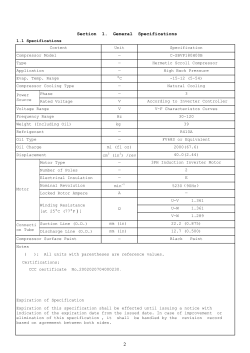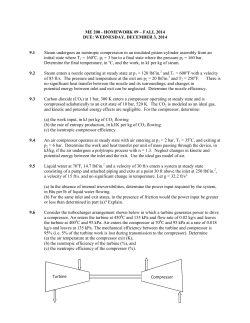
Transcritical CO2 2.cdr
Components for Transcritical CO2 Systems Oil Management Controls OIL RESERVOIR Maximum Working Pressure of 1,885 PSI OIL SEPARATOR Oil Separation Efficiency up 97% henrytech.com OIL SEPARATORRESERVOIR Maintenance Free Oil Management Controls The function of a helical oil separator is to efficiently remove oil from the discharge gas and return it to the compressor, either directly or indirectly. This helps maintain the compressor crankcase oil level and raises the efficiency of the system by preventing excessive oil circulation. The function of an Oil Reservoir is to provide a holding charge of oil. The amount of oil circulating in a system varies depending on the operating conditions and the oil reservoir caters for these fluctuations by providing additional storage capacity. Efficiency To establish the oil separator efficiency when used on transcritical CO2 applications Henry Technologies commissioned independent testing. The tests showed the resultant oil separator efficiency at capacities of 25% to 103%. Efficiency levels of up to 97% were recorded. The tests utilised a semi-hermetic compressor with a variable speed drive motor to enable the capacity to be adjusted. There are many factors that affect oil separator efficiency such as; discharge gas temperature and pressure; compressor oil carry-over and the density of the discharge gas and oil. Consequently oil separator efficiency varies on each system. Main Features Separator/Separator-Reservoir Materials of Construction The main components; shell, end caps and connections are made from carbon steel. ŸHigh oil separation efficiency - up to 97% ŸConsistent low pressure drop ŸNo clogging elements due to excessive oil in the system ŸNo oil blow-out at start up from oil left in a coalescing element ŸMaintenance-free ŸOil level sensor port (except STH-5392) Technical Specifications Allowable operating pressure= 0 to 1,885 PSI (130 Bar) Allowable operating temperature = +32°F to +284°F (0°C to +140°C) Henry Technologies' Oil Management Components are UL and C-UL Listed by Underwriters Laboratories, Inc. Oil Reservoir ŸTwo sizes available; 1.59 US gallons and 2.91 US gallons ŸClear sight glasses ŸOil level sensor port CRN Oil Separator COMPRESSOR PROTECTIVE DEVICES Part No 2 ODS (inch) STH-5193 1/2NPT STH-5196 3/4 NPT 1 NPT STH-5198 STH-5410 1 1/4 NPT STH-5411 1 1/2 NPT STH-5412 2 NPT Dimensions (inch) ØA B C D ØE F G H 6.63 6.63 6.63 6.63 8.63 8.63 25.12 27.44 29.41 29.61 32.32 35.47 7.52 7.52 7.52 7.72 8.03 8.27 7.95 10.28 10.28 10.28 10.28 10.28 9.10 9.10 9.10 9.10 11.14 11.14 7.95 10.28 10.28 10.28 10.28 10.28 N/A N/A N/A N/A N/A N/A 1.77 1.77 1.77 1.54 2.36 2.17 Visit our website: www.henrytech.com Mounting Details Fig No 3 x 0.55" slots 3 x 0.55" slots 3 x 0.55" slots 3 x 0.55" slots 3 x 0.55" slots 3 x 0.55" slots 1 1 1 1 1 1 Pre-charge Weight qty (gal) (lbs) 0.16 0.16 0.16 0.16 0.16 0.16 68.34 68.34 74.96 76.06 125.66 141.10 Oil Separator-Reservoir Part No ODS (inch) Dimensions (inch) ØA STH-5392 1/4 NPT 2.87 1 NPT 6.63 STH-5398 *Indicates reservoir capacity B C D ØE F G H 27.36 39.06 23.82 7.52 5.39 10.28 N/A 9.10 N/A 10.67 N/A 10.43 N/A 1.77 Mounting Details Fig No 2 x 0.55" slots 3 x 0.55" slots 2 3 Mounting Details Fig No 3 x 0.55" slots 3 x 0.55" slots 4 4 Pre-charge Weight (lbs) qty (gal) 0.29 1.77 13.67 99.65 Oil Reservoir ODS (inch) Dimensions (inch) ØA STH-9109 3/8 NPT 6.63 STH-9108 3/8 NPT 6.63 *Indicates reservoir capacity B C D ØE F G H 24.53 36.61 7.84 7.84 9.45 21.54 9.10 9.10 8.23 8.23 4.72 10.59 4.72 10.95 Fig. 1 Œ Ž ‘ Inlet Outlet Oil return, 3/8 NPT Sight glass Port, 3/8 NPT Level control conn,1/2NPT (except STH-5392) Fig.2 Fig. 3 Pre-charge Weight qty (gal) (lbs) 1.59 2.91 61.73 91.49 Fig. 4 Œ Ž ‘ ’ Inlet Outlet Level control conn, 1/2NPT Charging conn, 1/4 NPT Vent valve conn, 1/4 NPT Relief valve conn, 1/2NPT Sight glass (centre sight glass on STH-9108 only) COMPRESSOR PROTECTIVE DEVICES Part No 3 Performance Data The table provides a summary of the tons of capacity of each separator for fixed evaporating and condensing temperatures. The table can be used as a quick reference guide However; the Selection Guidelines are recommended for helical sizing. . Data Separator Performance Capacity in tonnage of refrigeration at nominal evaporator temperature (°F) 14 32 50 -4 59 -22 5.43 STH-5193 4.35 4.72 5.09 5.60 3.98 12.34 13.28 10.41 14.19 11.35 14.62 STH-5196 19.93 21.30 21.92 STH-5198 15.61 18.51 17.03 36.40 43.22 49.76 51.18 STH-5410 39.08 46.35 STH-5411 57.15 67.96 77.91 80.47 62.27 73.08 STH-5412 75.35 82.18 89.57 96.39 106.06 102.93 All data is based on 1,305 PSI high pressure, 95°F gas cooler, 46.4°F suction gas superheat and 41°F useful superheat. Part No Vol discharge (CFM) 1.53 4.00 6.00 14.00 22.01 29.01 Separator-Reservoir Performance Data Capacity in tonnage of refrigeration at nominal evaporator temperature (°F) 32 50 -4 14 -22 3.33 3.55 STH-5392 2.84 3.10 2.62 18.51 19.93 21.30 15.61 17.03 STH-5398 All data is based on 1,305 PSI high pressure, 95°F gas cooler, 46.4°F suction gas superheat and 41°F useful superheat. Part No Selection Guidelines The most important parameter for selection is the discharge volumetric flow rate, expressed in CFM. This is the calculated volume flow rate at entry to the oil separator. It is not to be confused with the compressor displacement or swept volume. To calculate the discharge volumetric flow rate, the maximum and minimum system mass flow rates are required along with the density of the gas at the inlet to the separator. These mass flow rates can either be calculated from first principles or by using refrigeration cycle analysis software. In this way, superheating (useful and un-useful) can be accounted for in the mass flow rate calculation. COMPRESSOR PROTECTIVE DEVICES The gas density at inlet to the separator is a function of both pressure and temperature. The inlet gas temperature is dictated by a number of system design factors including compressor performance. The gas will be in a superheated state. 4 Example:Refrigerant CO2 (R744) Maximum refrigeration capacity = 11.94 tons Minimum refrigeration capacity = 7.39 tons Evaporating temperature = 14°F Gas cooler outlet = 95°F High pressure = 1,305 PSI (a) Suction gas superheat = 9°F Useful superheat = 9°F 59 3.67 21.92 Vol discharge (CFM) 1.00 6.00 3 Calculated minimum discharge volume flow rate = 1435.21 = 141.96 ft /hr 10.11 3 Using these ft /hr figures, the recommended helical separator selection is model STH-5196 (reference additional note 3 for guidance on minimal under-sizing). Additional notes on selection:1. It is recommended that the separator is not operated below 25% of its rated maximum capacity. This is to optimise efficiency. On systems with extreme unloading conditions, one separator per compressor should be used rather than one separator for a common discharge line. 2. Understanding the system refrigeration capacity and the percentage of full and low load run times can also be helpful in selecting the separator. 3. In cases where the maximum discharge has been exceeded by only a minimal amount and the system has unloading characteristics, select the smaller separator. It is not recommended to oversize. Installation – Notes 1. Oil separators are not 100% efficient, so installing an oil separator should not be viewed as a replacement for oil traps, suction line accumulators or good oil return piping practices. 2. An initial oil pre-charge of 1.59 US gallons is required. 3. Install the oil separator/separator-reservoir vertically and From analysis software:- reasonably close to the compressor. Proper piping practice Maximum mass flow rate = 2319.26 lbs/hr Minimum mass flow rate = 1435.21 lbs/hr Gas density, superheated, at inlet to separator = 10.11lb/ft3 should be adopted to prevent excessive loads or vibration at the inlet and outlet connections. The separator/separatorreservoir must be properly supported at the bottom mounting feet interface. Note: Mass flow rate = [(Tons of refrigeration/ refrigerating effect) x 3600] Use the equation:Discharge volume flow rate = Mass flow rate Gas density Hence for this example:3 Calculated maximum discharge volume flow rate = 2319.26 = 229.4 ft /hr 10.11 Visit our website: www.henrytech.com 4. A check valve should be located downstream of the separator/separator-reservoir outlet connection. This check valve is to prevent liquid refrigerant migrating from the condenser/gas cooler.
© Copyright 2025















